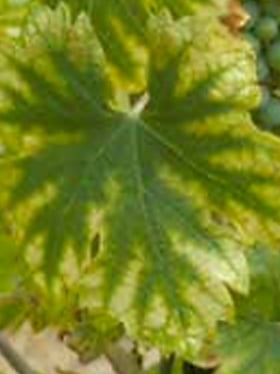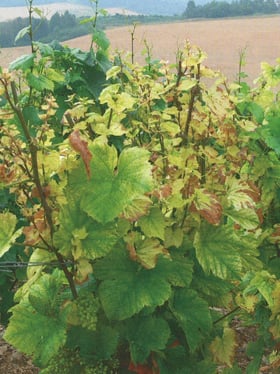Growing Grapes
Everything you need to know about grape and vineyard fertilization, best practices, suitable products, field trials, and more
Advice for growing Wine grape and Vineyards (Vitis vinifera)
-
Soils: Grapevines can adapt to a wide range of soil types, and if soil depth, texture, and water conditions are favorable, will survive and bear good quality crops in soils with poor fertility. Grapevines require well-drained soil.
-
In soils with high pH (above 7.5), deficiencies of phosphorus and micronutrients such as iron may appear.
-
If soil is deep enough, grass can be implemented between the rows to prevent erosion and weeds.
-
Site selection: Localized micro-climates play an important role in the feasibility of planting grapes on a specific site. The most important features are temperature and drainage.
-
Wine grapes typically prefer a hot, dry climate with warm days, cool nights, and low humidity. These generally produce higher-quality grapes.
-
The season at a particular site must be long enough to allow both the fruit and the vegetative parts of the vine to mature. It must provide enough heat to ripen the fruit and vegetation.
-
Winter must be long and cold enough to ensure a dormancy period. Late spring frosts provide a threat to the young buds, as they are sensitive to freezing temperatures, which can damage and destroy flower clusters.
-
There must be adequate sunlight hours to ensure adequate photosynthesis for sufficient supply of carbohydrates to mature the fruit and vine.
-
Rainfall occurring during the ripening period may favors various grape diseases.
-
Drip irrigation optimizes water supply for grapes production. It is an increasingly common irrigation method in intensive growth environments, enabling longer production periods, better quality, and higher yields.

Burgundy Vineyard landscape

Grape of Meunier in Champagne area before closing of the cluster.
Nutrient requirements
Grapevines have fewer mineral deficiencies and a lower plant nutrients demand than many other horticultural crops.
Phosphorus, potassium, and lime applications should be based on soil tests and leaf-analysis results.
Nitrogen fertilizer should be applied during periods of active uptake, to minimize loss through soil leaching.
This includes the period from bud-break to veraison, and if leaf fall has not occurred, immediately after fruit harvest.
Multiple applications of nitrogen are preferred over one large spring application. Most nitrogen forms can be used equally in vineyards.
Dynamic of nutrient uptake over a crop season in vineyards

The following nutrient uptake patterns can be seen above:
•N uptake is relatively low in early season, it rises sharply until fruit-set, then decreases sharply until harvest, and increases sharply again after harvest.
• P follows a similar pattern, but it only increases after harvest
• Initial K uptake rate is higher than N or P, declines until harvest, and recovers slightly after harvest
Role of nutrients
Nitrogen
Promotes high yields and ensures vegetative growth of the crop.
Plays a key role in synthesis of proteins, which are directly involved in growth and yield.
Phosphorus
Promotes development of a good root system. A prerequisite for flowering and therefore number and retention of fruits.
Essential for maintaining plant energy. Enhances cell division.
Potassium
Enhances transport of sugars to the fruits. A co-factor of many enzymes. Regulates water management, mainly through stomatal aperture.
Enhances sugar content of the fruit. Reduces susceptibility to many kinds of abiotic and biotic stresses. Improves deep green fruit color, firm flesh, shape, and overall yields.
Calcium
Promotes cell-wall stability, hence providing the plant a strong structure, and resistance to diseases.
Adequate calcium prevents blossom-end rot (BER). It also provides improved shelf life.
Magnesium
Is the central part of chlorophyll molecule, playing a key role in photosynthesis. Increases Fe utilization.
It is both an enzyme activator and a constituent of many enzymes. Helps obtaining a deep green fruit color.
Iron
Essential for proteins and chlorophyll synthesis. Important factor in many enzymes, associated with energy transfer and respiratory systems.
Manganese
Translocation of sugars and carbohydrates. Pollination and seed production. Cell division and cell-wall formation, related to Ca uptake and usage.
Zinc
Production of auxin, an essential growth hormone. Promotes proteins and chlorophyll synthesis. Necessary for starch formation and proper root development.
Copper
Involved in metabolism of N and carbohydrates. A catalyst in photosynthesis and respiration. Included in enzymes involved in building and converting amino acids to proteins.
Molybdenum
Important to nitrate reductase activity, converting nitrates to aminoacids. Conversion of inorganic P into organic forms.
Nutrient deficiencies
| Nutrient | Description | |
|---|---|---|
| Nitrogen | Shoot growth slows and ceases in midsummer Mature leaves are uniformly small and light-green or yellow. •Shortened internodes • Delayed fruit ripening • Poor fruit quality, including poor color in red varieties • Total N in bloom-time petiole: <1%; Nitrate-N in bloom-time petiole: <350ppm Ref.: Christensen |
|
| Phosphorous | • P- deficient plants have weak roots, are stunted, and produce small, dark green or brown leaves. • Fruit-set is reduced, thus impairing production. • Phosphorus deficiency is most common when soil pH is too low (<5.5) or too high (>7.0). Ref.: Christensen |
|
| Potassium | • The old leaves are the most sensitive ones, they exhibit marginal chlorosis, and in severe cases the leaf margins dye. • A dull dark green color appears on the leaves. In mid- to late- summer leaves may have a bronze color, especially on west-facing side of the trellis. Some leaves may develop dark spots or blotches. • K-deficiency can be aggravated by application of dolomitic limestone, which is used for raising soil pH and enriching the soil with Mg. • Severe K deficiency markedly reduces vine vigor, berry size, and crop yield. Ref.: Christensen |
|
| Magnesium | • Yellowing of older leaves, beginning between the major veins, which retain a narrow green border. This interveinal chlorosis shows first as scattered blotches. Younger leaves are less affected. Unless the deficiency is severe, it does not become evident until late summer. • Young terminal leaves may never show symptoms unless the entire vine is extremely affected. • Yields are reduced. • Mg deficiency can reduce yield and delay ripening if leaf chlorosis becomes severe enough to inhibit photosynthesis. • Deficiency occurs mainly in plots with pH < 5.5, and plots that have received high N, Ca or K fertilizer rates, on light soils and in very dry years. Ref. Dami & al., Ohio,2005 |
|
| Iron | • Pale interveinal yellowing appears on younger leaves first. All other leaves remain dark green. • Reduction in shoot growth and yield. • Iron-deficient plants are yellow and stunted. • Most often observed when growing in alkaline (pH > 7.0), or calcareous soils, and can be induced also by over- liming and poor drainage. Ref.: Christensen |
|
| Manganese | • The symptoms appear in mid-to-late summer, as an interveinal chlorosis on young, fully-developed leaves. • Mn deficiency occurs on pH > 7 soils, and on sandy-, calcareous- , or excessively limed soils. |
|
| Molybdenum | • Older leaves are affected first, as a whitish-tan interveinal chlorosis, accompanied by marginal leaf burn in severe cases, followed by death of the tissue at the margins. • Plants can be severely stunted. |
|
| Zinc | • Young leaves appear yellow and tend to be smaller in size. • Interveinal yellowing similar to Fe deficiency. • New growth is adversely affected with shorter internodes that produce stunted shoots. • Older leaves show initially yellowish-green interveinal chlorosis, developing later to yellow/ whitish. The veins keep their green margins. • Fewer flowers, that may be infertile. • Withered clusters with tiny, under-ripe berries. |


Nitrogen deficiency Phosphorus deficiency


Potassium deficiency Magnesium deficiency


Manganese deficiency Iron deficiency


Zinc deficiencies
Fertilization methods
Soil application
Apply nitrogen within 30-60 cm of the vine by banding + immediate disking, or by fertigation. If nitrogen fertilization is needed, annual application of 35-60 kg/ha of actual nitrogen, on sandy loam soils, is a good starting point for mature vineyards. Young vineyards (1st and 2nd growing season) in need of nitrogen fertilization, typically require no more than 30 kg/ha of actual nitrogen.
Fertigation by drip irrigation in open fields and protected management
As drip irrigation is so common with this crop, fertilization is generally done by fertigation, using fully-soluble fertilizers, adapting the N-P-K-Ca-Mg ratios according to the crop’s needs at every growth stage.
Foliar feeding
A properly applied foliar spray program usually focuses on micronutrients and can be beneficial. Before applying any nutrient spray, a laboratory petiole analysis from affected and normal leaves, and a soil analysis, should be performed. This can help make an educated decision, with more evidence than just visual symptoms. Zinc deficiency may be corrected by applying a foliar spray 2-3 weeks before bloom. As Fe is immobile in plants, spray only existing foliage. If chlorosis is severe and persists, repeated applications at 10-20-day intervals may be necessary.
Q&A
Here are some frequently asked questions we received from farmers regarding growing vineyards.
-
Nutrients should be applied every year including the year of establishment. However, the nutrients used and amounts applied will change over time as the vines transition into bearing fruit.
-
All of these are appropriate choices and will vary by the grower’s application capabilities and objectives. These approaches could also be used in combination to supply the optimal source and timing of each nutrient required.
-
Usually K/Mg in wine grape soil should be between 2 and 3, so a fertilizer such as Polysulphate will maintain such a ratio.
-
A supply of potassium in the plant will ensure a sufficient harvest and good sugar content. Polysulphate ensures availability of a low-chloride source of potassium throughout the crop cycle.
-
The likely outcome will be chlorosis of the plant and reduction of photosynthesis. As a result, the grapes might not form with all of the necessary compounds to make a good wine. Polysulphate ensures availability of these nutrients throughout the crop cycle.
Need expert advice on your plant nutrition plan?
Proven in Grapes











